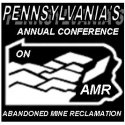
EPCAMR Staff feels this is the most extensive recount of coal mining impact on those who live in and work in the coal region by a newspaper investigation. Thank you, Scranton Times, for working with us!
Investigation Navigation
________________________________________
Part 1 – 1/30/2005
Too Many Mines, Too Little Money
State Program Trying To Make Up for Lost Federal Contributions
Part 2 – 1/31/2005
Danger Lurks in Mines
Part 3 – 2/1/2005
Mining for Solutions
Competing Plans
Successful Reclamation Results are All Around
Orange Water, Silver Lining
________________________________________
Mining for Solutions
2/01/2005
If Mary Lou Callaio had her way, there would always be federal dollars available to clean up abandoned mines.
Without it, she said, families like hers could face financial ruin.
Two years ago, the ground opened beneath the Callaios’ Pittston home, engulfing half their cellar. Fortunately, the couple’s three children were not in the basement at the time. Their oldest daughter had been in the cellar not long before to store some boxes.
The Mill Street house has been in Mrs. Callaio’s family for 113 years. Official mining maps did not show a mine shaft under the home, so the family did not have mine subsidence insurance under the homeowners’ policy.
The house sits next to the spot where nearly 61 years ago, a 6-foot hole opened up on the sidewalk, killing a 2-year-old girl who fell nearly 30 feet in the cavern. Another neighbor had a hole open beneath her front porch twice over the years, once killing her cat.
State and federal officials came immediately to the Callaio house to help the family. Emergency mine subsidence funding provided nearly $25,000 to repair the basement and relocate the family while work was being done.
“We would have had a costly repair because the insurance didn’t cover it,” Mrs. Callaio said. “We were lucky. No one got hurt. We did lose a lot of items. They’re gone. There’s no possible way they can get rid of that program. Who knows when the next mine shaft will open up and someone needs help?”
The federal government established a mine cleanup fund in 1977 through the federal Surface Mining Control and Reclamation Act. The fund is paid for through a tax on coal companies. Over the years, the language of the act has been loosened to allow some states to use cleanup money for noncoal projects and nonthreatening mine reclamations. Program oversight is now lax.
Today, there isn’t nearly enough money to clean up the 9,100 remaining inventoried abandoned mine sites nationwide.
The coal tax generates about $287 million annually, mostly from Western states, where more of today’s coal mining is done.
The fund is set to expire in June, and lawmakers are divided over what to do with it. The division extends across political parties and geographical loyalties.
EASTERN NEEDS
Eastern legislators, particularly those in Pennsylvania, say historical mine problems are everyone’s responsibility, since those states fueled the nation and paved the path for coal companies to operate today. They want mine cleanup money to go where it is most needed.
Pennsylvania has the biggest need. About 57 percent of the estimated $8.6 billion remaining inventoried mine sites needing cleanup nationwide are in the state. There are 2,075 remaining inventoried abandoned mines in Pennsylvania.
Among state lawmakers, there are two main proposals for extending the program. U.S. Sen. Arlen Specter, R-Philadelphia, has sponsored a bill, with U.S. Reps. Don Sherwood, R-Tunkhannock, and John Peterson, R-Pleasantville, co-sponsoring a House version. U.S. Rep. Paul E. Kanjorski, D-Nanticoke, also has a proposal.
“I’m for bringing the largest share to Pennsylvania,” said Mr. Sherwood. “We have the greatest need. But part of the problem will be getting states like Wyoming to agree to continue paying the tax on coal mines when they don’t have mine reclamation projects.”
Pennsylvania has the greatest number of people in danger because of abandoned mine problems, Mr. Specter said. The commonwealth has more than 250,000 acres of abandoned surface mines, 2,400 miles of polluted streams caused by mine drainage, and 38 underground mine fires, he said.
Mr. Specter’s proposal, which is backed by President Bush, would increase abandoned mine cleanup funding in Pennsylvania from about $25 million to more than $35 million annually over the next 15 years. It also calls for phasing out the coal tax until 2018, when it is projected that all the abandoned mine problems will be resolved.
Nationwide, higher-priority abandoned mine sites would be reclaimed in about 25 years instead of 60, while actually saving the program more than $3 billion, Mr. Specter said. Among the most significant changes would be distributing funds to states based on their historic coal production, he explained.
But Mr. Specter’s proposal does not give enough money to Pennsylvania to take care of all the abandoned mine problems, said Mr. Kanjorski. More money is needed, he said.
Under his proposal, a special tax credit bond would be created for abandoned mine reclamation. The bonds would allow local communities to manage their reclamation efforts with more flexibility and get all abandoned mines cleaned up faster, he said.
Meanwhile, Mr. Kanjorski favors a proposal sponsored by a Wyoming lawmaker and fellow Democrat from West Virginia.
WESTERN WANTS
U.S. Reps. Barbara Cubin, R-Wyo., and Nick J. Rahall, D-W.Va. want to allow Wyoming and other coal-producing states to continue receiving payments from the federal mine cleanup fund even though they do not have historical abandoned mine problems.
The proposals of Mr. Specter, Mr. Sherwood and Mr. Peterson redirect all future payments to reclaim abandoned coal mines in Appalachian states where there are mines to be reclaimed.
Western lawmakers say if their states continue to be the primary source of money for the mine cleanup fund, they should be able to spend the money on noncoal projects, since all or most of their abandoned mines have been reclaimed.
Wyoming, which now contributes more money to the fund than any other state, needs the money to pay for schools and roads and other public works projects, Ms. Cubin said. The state was certified in 1984 as having all its abandoned mine sites reclaimed. Changes to the law allow certified states to now spend mine cleanup dollars on noncoal projects, with Wyoming spending about $93 million on such work.
The Cubin-Rahall plan reduces the coal tax that fuels the fund. States would also be reimbursed back money they are owed with no strings attached, under the proposal.
For Wyoming, that translates into about $450 million the most any state is owed. Pennsylvania would receive about $56.3 million.
The plan also calls for taking the cleanup funds “off budget,” which means states would get federal dollars without having to wait for Congress to release money.
Currently, the fund is “on budget,” which means the money is held in a treasury pool and cannot be spent until Congress says so. As a result, more than $1.7 billion of mine cleanup money is sitting in a federal trust fund to help keep deficit more balanced.
“I am in favor of releasing the money in the trust fund,” Mr. Kanjorski said. “At the present rate, it would take (hundreds of) years to reclaim all the abandoned mines. I want to go at it fast and furious and get these mines cleaned up at once.”
GROWING PROBLEMS
No matter which bill passes after legislators reintroduce their proposals this Congressional session, experts predict there will still be a lack of money.
States continue to add to the list of abandoned mine sites as new problems are discovered.
“No one knows for certain how many abandoned mines there really are,” said Carol Raulston, a spokeswoman for the National Mining Association. “States have inventories but problems arise. New abandoned mines are discovered. It’s a growing problem.”
For Mrs. Callaio, the growing need for mine cleanup was brought home in September after Hurricane Ivan hit and another crack appeared in her repaired basement floor.
It was not until December that state and federal officials were able to come back to examine the damage.
“If it took that long for them to get to us, there has to be a need for the program,” she said. “Every time I hear a noise in the house, I jump. The cats and kids are no longer allowed in the basement. There’s not a whole lot under the house. We need the program, especially in my neighborhood.”
©Scranton Times Tribune 2005













You must be logged in to post a comment.